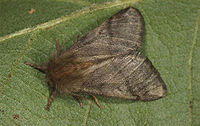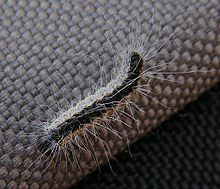- Oak Processionary
-
Oak Processionary Oak Processionary caterpillars in a nest on an oak tree trunk Scientific classification Kingdom: Animalia Phylum: Arthropoda Class: Insecta Order: Lepidoptera Family: Thaumetopoeidae Genus: Thaumetopoea Species: T. processionea Binomial name Thaumetopoea processionea
Linnaeus, 1758The Oak Processionary (Thaumetopoea processionea) is a moth whose caterpillars are pests in oak forests and pose a health hazard because of their poisonous setae (hairs), which may cause skin irritation and asthma.
Contents
Distribution
The moths are widely distributed in central and southern Europe, and are occasionally found as far north as Sweden. In the southern countries of Europe the populations are controlled by natural predators, but these predators do not exist in northern Europe. Their range is expanding northward, possibly or partly as a result of global warming.
Description
The wingspan of adult stage moths is between 25 and 35 mm. Their pattern of tan, brown and white make the adults difficult to see against oak bark. Adults fly during July and August. The larvae construct communal nests of white silk from which they crawl at night in single file, head to tail in large processions to feed on foliage in the crowns of trees, returning in the same manner.
Oak is its preferred food source, but it also attacks hazel, hornbeam, sweet chestnut, birch and beech.[1]
Public Health Problem
The moths are posing an increasing threat to humans as their range is being extended by the warming European climate. The backs of older caterpillars (3rd to 6th instars) are covered with up to 63,000 pointed defensive bristles containing an urticating toxin (thaumetopoein or closely related compounds). The setae break off readily, become airborne and can cause epidemic caterpillar dermatitis (lepidopterism), manifested as a papular rash, pruritus, conjunctivitis and, if inhaled, pharyngitis and respiratory distress, including asthma or even anaphylaxis.
Control
England
Infestations of this caterpillar were first found in several locations in London in 2006. The general public have been asked to look out for these caterpillars and to report them, rather than deal with them themselves. The London Boroughs of Brent, Ealing, Hounslow and Richmond upon Thames have set up task forces to deal with outbreaks. Sightings of these caterpillars in other areas should be reported to the Forestry Commission.[2] The research agency of the Forestry Commission has issued guidance on the way to contain outbreaks and deal with infestations, so as not to increase the risk to the public.[3]
An emergency amendment came into force on 31 March 2008, which added the moth to the list of pests in The Plant Health (Forestry) Order 2005, and requires all oak trees coming into the UK from the rest of Europe to have Plant Passports.[4]
Belgium
In 2007 infestations in the Belgian province of Limburg were so acute that governor Steve Stevaert deployed 20 soldiers to burn them [2].
References
- ^ Tree News Magazine, Autumn/Winter 2007, page 4 internal Sylva supplement
- ^ The Forestry Commission. Oak processionary moth. Accessed 2008-05-31
- ^ Forest Research Survey and intervention in relation to different phases of the oak processionary moth life cycle. Accessed 2008-05-31
- ^ Office of Public Sector Information. Explanatory memorandum to the Plant Health (Forestry) (Amendment) Order 2008 No. 644.[1] Accessed 2008-05-31
- Maier, H. et al. (2003) British Journal of Dermatology 149(5):990-997, November.
External links
Categories:
Wikimedia Foundation. 2010.




